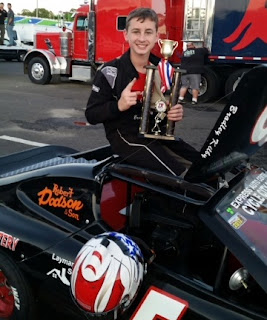HONDA RACING AT SEMA 2017
The American Honda Motor Company booth at the 2017 SEMA (Specialty
Equipment Market Association) show was heavily populated with racing machines.
Honda Concept Kart
The Honda Concept Shifter Kart is powered by an electric
start 250 CC single cylinder liquid cooled engine four stroke engine CRF250R
connected to a five-speed transmission in a Aluminous Kart chassis.
Honda F3
The 2018 F3 Americas Series racer drew a lot of attention due
to its FIA-approved Halo concept cockpit protection on its Ligier Crawford
carbon fiber moncoque chassis which features adjustable front and rear wings.
The F3 racer is powered by a 270-horsepower turbocharged fuel-injected Honda
K20 motor as used in the Honda Civic Type R connected to a sequential Sandev
six-speed transmission which is shifted by the driver with paddles adjacent to
the steering wheel.
The F3 Americas series sanctioned by the Sports Car Club of
America (SCCA) will debut in April 2018 with a total of six race weekends which
will feature two 30-minute races per weekend. The 2018 F3 races will be contested at
Virginia International Raceway, Road Atlanta, Mid-Ohio Sports Car Course,
Pittsburgh International Race Complex, New Jersey Motorsports Park with the
season finale at the Circuit of the Americas in Texas.
Acura ARX-05
For the 2018 IMSA Weathertech Sportscar season, Team Penske will
campaign the Acura ARX-05 DPi prototype. The Oreca 07 chassis will be powered
by the Acura 3.5-liter AR35TT twin-turbo V-6 engine which is used in the Acura MDX,
RDX, TLX and RLX passenger cars tuned to produce around 600 horsepower.
Two Team Penske Acura ARX-05 racers will debut in the Rolex 24 hours
of Daytona scheduled for this weekend January 27 and 28 2018. The Acuras will
have a powerful drivers lineup that includes 2017 IMSA Weathertech Sportscar
champion Ricky Taylor, Graham Rahal and three-time Indianapolis 500-mile race
champion Helio Castroneves in the #7 car.
2016 INDYCAR champion Simon Pagenaud, two-time Indianapolis
500-mile race champion Juan Pablo Montoya, and 2014 IMSA GTD champion Dane
Cameron will be teamed in the #6 entry. Taylor and Castroneves will team to
compete on the entire 2018 IMSA Weathertech Sportscar championship trail in one
car with Cameron and Montoya teammates in the other car.
Acura TLX GT
This specially prepared Acura TLX racer driven by Peter Cunningham
set a new Open Class record at the 2017 Pikes Peak International Hill Climb, finished
second overall and earned Cunningham Rookie of the Year honors at the “Race to
the Clouds.” The Acura’s steel unibody was fitted a full steel roll cage carbon
fiber hood, trunk deck, front splitter and massive rear wing The car is powered
by a modified Acura J35Z3 3.5 liter fuel-inject SOHC engine mated by an
all-wheel drive system which propelled the TLX up the mountain in a time of 9
minutes and 33.797 seconds.
Acura NSX Time Attack
This modified Acura NSX GT3 racer finished third in the Time
Attack class at the 2017 Pikes Peak International Hill Climb driven by James
Robinson. Basically a production car with a huge rear wing added, tuning was accomplished
through modifications of the Acura Sport Hybrid Super Handling all-Wheel drive
system. The output of the 3.5-liter twin turbocharged V-6 engine is
supplemented by a direct driveshaft electric motor to the rear wheels and a
pair of electric motors acting on the front axle.
All photos by the author













































